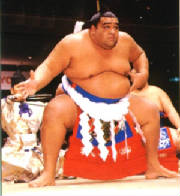 |
|
Marushikis rantings
|
|
Sumo
|
 |
 |
|

|
Information found from http://sumo.goo.ne.jp/eng/ozumo_joho_kyoku/shiru/kiso_chishiki/beginners_guide/origin.html
A ccording to Japanese legend the very origin 
of the Japanese race depended on the outcome of a sumo match. The supremacy of the Japanese people
on the islands of Japan was supposedly established when the god, Take-mikazuchi, won a sumo bout with the leader of a rival
tribe. Apart from legend, however, sumo is an ancient sport dating back some 1500 years. |

 |
I ts origins were religious. The first sumo matches were a form of ritual
dedicated to the gods with prayers for a bountiful harvest and were performed together with sacred dancing and dramas within
the precincts of the shrines. |
| The Nara Period(The 8th century)sumo was introduced into the ceremonies of the Imperial
Court. A wrestling festival was held annually which included music and dancing in which the victorious wrestlers participated.
Early sumo was a rough-and-tumble affair combining elements of boxing and wrestling with few or no holds barred. But under
the continued patronage of the Imperial Court rules were formulated and techniques developed so that it came more nearly to
resemble the sumo of today. |
 |

 |
A military dictatorship was established in Kamakura in 1192
and a long period of intense warfare ensued. Sumo, quite naturally, was regarded chiefly for its military usefulness and as
a means of increasing the efficiency of the fighting men. Later in the hands of the samurai, jujitsu was developed as an offshoot
of sumo. Peace was finally restored when the different warring factions were united under the Tokugawa Shogunate in 1603.
A period of prosperity followed, marked by the rise to power of the new mercantile classes.
Professional sumo groups were
organized to entertain the rapidly expanding plebian class and sumo came into its own as the national sport of Japan. The
present Japan Sumo Association has its origins in these groups first formed in the Edo Period.
|
|
|
Why the name Marushiki.... Well in 1997 the Sumo Wrestlers came to Australia and did a Demonstration match in Melbourne
and Sydney... I saw them on TV and fell in love with some of them.. Namely Musashimaru and Konishiki, and Akebono.
All these three Rikishi(wrestler) have retired. Not long after I started investigating what was sumo!!!!
and found a Wonderful bunch of enthousiasts... They even had online games to play, and you had to have your own Shikona
(fighting name.) after much consideration, i thought out of my crazyness for the 3 rikishi, i would choose part of their
names and use that as my shikona... so i toyed around with several options and asked a japanese friend for what they
meant.. So I came up with several options like. Akemaru, Konimaru Koniono, Maruono and a few others... finaly
settling on MARUSHIKI.
|
|
|
|
|
|
|
|
|
|
|
|
sumo terminology
These are just samples of some things you can find. For more words Please click on the above link
|
Banzuke |
The official listing of rank in ozumo |
| Danpatsu-shiki |
A rikishi's retirement ceremony in which his top knot is formally removed. |
| Gyoji |
The referees. There are eight ranks in this profession, with promotion based
on a combination of seniority and competence. Each gyoji will take one of two "clan" names as his family name; Kimura or Shikimori.
|
| Ozeki |
The second highest rank in ozumo |
| Yokozuna |
The highest position on the banzuke or official listing of rank, the yokozuna are often referred to as the living symbols
of sumo. |
Rules of Sumo (again more information can be found from
the above link)
A bout is won by forcing the opponent out of the inner circle or throwing him in the
dohyo. To lose the match it is not necessary to fall in the circle or to be pushed completely out. The rikishi who touches the ground with any part of his body, his knee or even the tip of his finger or his top-knot, loses the match.
Or he need only put one toe or his heel over the straw bales marking the circle. Striking with fists, hair pulling, eye gouging,
choking and kicking in the stomach or chest are prohibited. It is also against the rules to sieze the part of the band covering
the vital organs. As there are no weight limits as in boxing or western wrestling it is possible for a rikishi to find himself pitted against an opponent twice his own weight.
more sumo info click on link
SUMO PT. 2
|
|
|
|
|
|
|